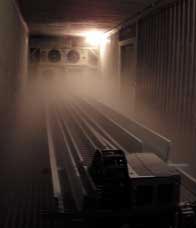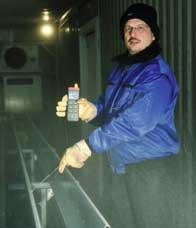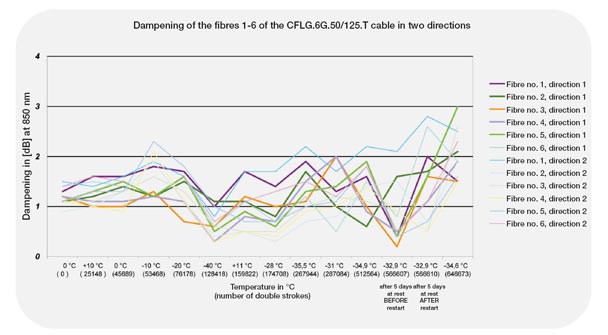Example 10: Tested, light in the cold

In the safe transmission of large amounts of data in bus systems at high speeds over long distances, the igus® gradient fiber glass cable of the type CFLG.G has already become a standard in numerous applications in cranes. Insensitivity to electro-magnetic load and resistance to hard environmental influences enable the application together with energy supply cables in very long travels.
What happens in crane facilities in regions with extremely low temperatures? Does the maximum possible cable length of several hundred meters reduce through increase in damping at low temperatures, or does the cable break in extreme applications, for example at -40° C?
The sensitive glass fibers are conducted in a gel-filled hollow space. How does the gel behave in highly dynamic conditions and what happens in restarts after long downtimes? As no precise statement about this topic could be found in relevant technical journals, and as little was known particularly about the thermal features of the gel, igus®, as part of its philosophy, undertook own tests to determine the reliable specifications for applications in E-Chain® systems.
For this task, the igus® test laboratory was equipped with a freezer that can generate constant temperatures of -40° C and a test facility was mounted for long travels up to 7 m for a speed of 1.6 m/s and an acceleration up to 6 m/s2.
The igus® gradient fiber glass cable CFLG.6G was tested. 50/125.TC. The cable was tested with a length of about 15 m as loop in an igus® E-ChainSystem® 3500.125.200.0 with a radius of 200 mm.



Varied and extreme temperature curves thereby served for the simulation of environmental influences, particularly when the temperature plunged during downtimes from plus degrees to -40° C in the shortest time and the motion was restarted afterward.
Under these application conditions, the dampening of the cable also should not rise above 3 dB at 850 nm wave length. The maximum dampening occurs after a million double strokes, which corresponds to an operational performance of about 7000 km, still distinctly under 3dB.
The measurements highlighted in the diagram reveal that marked variations in temperature combined with the constant movement in the E-Chain® have only minor effects on the dampening of the CFLG.6G. Show TC cable. The noticeable high initial dampening is attributed to the plugs used and reflects the reality here as well, as in practice 90% of cables used in automation are pluggable fiber optic cables.
The test with the igus® cable makes it quite clear that only realistic and absolutely very expensive tests can fetch clarity about the service life of cables.
More than 100,000 products available! Delivery and consultation Mon-Fri from 7am-8pm and Sat from 8am-12pm!
